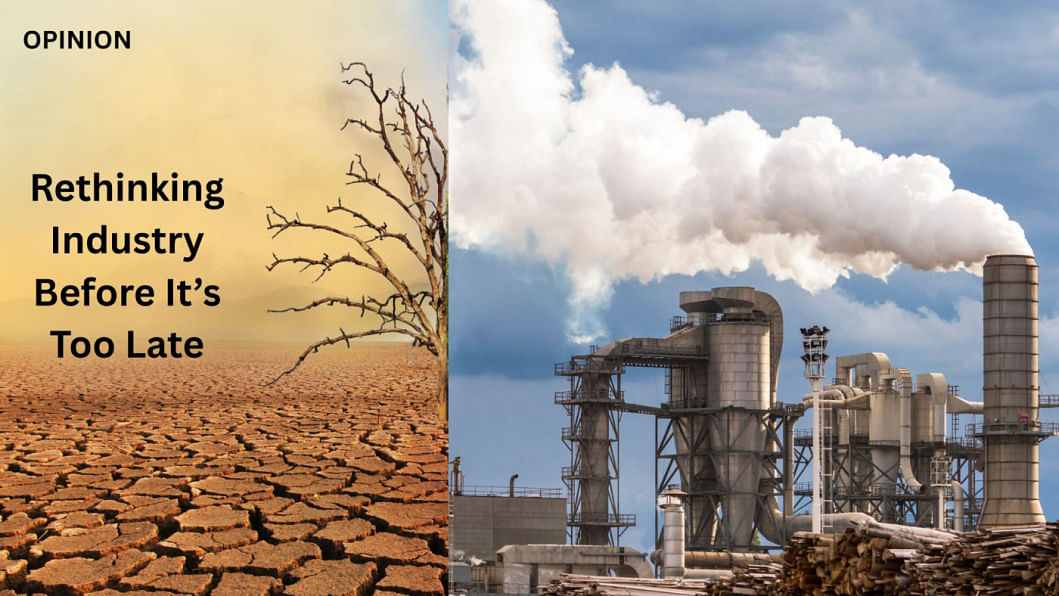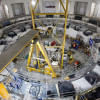Building dreams without breaking the planet

Try to lay back and think about 1990's Bangladesh, when a nation was struggling with poverty, rampant power outages, and torpid industries. In that year, Bangladesh's total industrial gross domestic product (GDP) was around $15 billion, which boomed and increased to over $115 billion by 2023—a staggering eight-fold growth.
We have developed ceramics, textiles, steel, FMCG, energy, construction, and further industries. As a nation, we grew, created jobs, alleviated millions from the ruthless grip of poverty, and uplifted living standards. We rebranded ourselves from a "basket case" to a development marvel. We converted the "Made in Bangladesh" label into a legacy. But here's the uncomfortable truth: the overwhelming ecological toll we are paying for this exponential growth.
Our beautiful country, nature, and ecosystem are struggling to cope; rivers are suffocating due to industrial waste, and continuously increasing passive emissions of carbon as we chase prosperity, while air pollution is shaving years off life expectancy. The most critical question is no longer about the potential for growth; rather, it is about how to achieve it. Can we industrialize without destroying ourselves? Or will the future generation look back at our actions and ask, "Our ancestors built the economy but destroyed the land that fed it?"
The industrial sector of Bangladesh is responsible for 35 percent of the GDP and the employment of 20 million people. The driving forces of export include textiles, pharmaceuticals, and leather, while ceramics, construction, and retail are driving domestic demand. But our environmental metrics are telling a different, grim story:
Dhaka ranked among the top 20 cities with the worst air quality, with an AQI score in the moderate to unhealthy range.
Around 50 percent of the water of the Buriganga is biologically dead due to pollution.
In our ceramic industry, the average Bangladeshi plant still depends significantly on virgin raw materials along with fossil fuel-based kilns, while global brands from Italy are switching to circular and hybrid energy systems.
No singular person can take the blame for this; rather, the whole industry is responsible in this regard. But we can't be blind builders anymore!
Many industrialists hold this thought firmly in their minds: "Let's cross the break-even point and get rich, then we will go green," but this is a hazardous illusion. The threat of climate change is real, and it is ticking right on our necks. The way the temperature is rising, by 2050, it can slash Bangladesh's GDP by 6.8 percent annually. Soil erosion, water scarcity, and extreme weather will eventually hinder supply chains, increase costs, and create imbalances in the market. So, sustainability is no longer idealism; rather, it is survival economics.
The industrial era that strengthened us will not sustain us. Those who extract value without depleting resources, rebuild things without ruining them, and create employment without emitting destruction are the visionaries—the future belongs to them only.
Let's not wait for international clients, sanctions, or any climate disaster to wake us up from this illusion. The signs are already very loud and clear:
By 2030, leading global fashion brands have demanded net-zero emissions from their supply chain partners.
Exporters with higher carbon footprints will be penalized under the EU Carbon Border Adjustment Mechanism (CBAM).
Traditional plants are being replaced by green financing; those who will not comply or are not ESG-aligned will not sustain.
Factories using solar or waste-heat recovery systems are experiencing 20–30 percent lower operational costs (BERC).
According to a published paper by Nielsen, 73 percent of global consumers now demand eco-conscious brands or products.
So, ask yourself this question first:
Would your factory survive if it had to substantiate its environmental integrity tomorrow?
Because while purchasing a T-shirt, an American customer prioritizes the type of water that dyed it, the energy that stitched it, and the process through which it was transported to her home—not the country or place where it was produced.
A ceramic buyer from Dubai is no longer looking for just regular tiles; rather, he prefers tiles made with recycled materials, crafted by people with dignity, and produced by a company that cares about more than profit.
An investor is not eyeing revenue alone. He looks at a company's resiliency, which comes from sustainability—not just scalability.
It's high time every industry implemented some basic tasks like:
Redefine Waste as Wealth
Start by considering every single "waste" stream as a future product line—be it fabric scraps, glass cullet, ceramic dust, steel slag, or heat byproduct.
Measure Before You Market
Energy audits, ESG scores, water impact reports—set them as your new KPIs. Start using numbers instead of buzzwords.
Design for a World That Cares
Products should serve their functions and feel ethical, polished, and tell a responsible story.
Train Minds, Not Just Hands
The next industrial revolution is going to be cognitive. Your employees, engineers, and sales force must all become ambassadors of sustainability.
This is not about compliance; rather, it is a vision. Because predictions say the next decade will reward those who see beyond profits. So the choice is yours:
Laggards: Stranded assets, regulatory penalties, and consumer backlash.
Pioneers: Dominate markets, attract investment, and secure a legacy.
I envision that by 2040, Bangladesh will:
Reward industrialists not just for competitive prices, but for planet-positive practices.
Through green corridors, clean environments, and thriving communities, turn industrial townships into livable ecosystems.
Use renewable energy and circular materials to convert factories into zero-waste campuses.
Have every single CEO fluent in carbon accounting—just like they are in revenue reports.
Some may think I'm fantasizing, but this is already a reality in parts of Europe and East Asia. We don't need to imitate them. Instead, we need to catch up—and lead.
In the next 10 years, Bangladesh is on its journey to transform into a middle-income country with over 50 percent urban population, a manufacturing-first economy, and rising global scrutiny.
Now the question we need to ask ourselves is whether we prefer to reach there as heroes of green growth—or as villains of climate failure.
We are no longer in the era of reckless expansion. We are in the era of conscious creation. Instead of becoming an industrial empire that collapses under its own weight, let us aim to become a role model for the future—where industry builds dreams, not disasters.
Bangladesh has experience building miracles before. Now it's time to build meaning. Let's build dreams—but not by breaking our beloved planet.

 For all latest news, follow The Daily Star's Google News channel.
For all latest news, follow The Daily Star's Google News channel. 








Comments